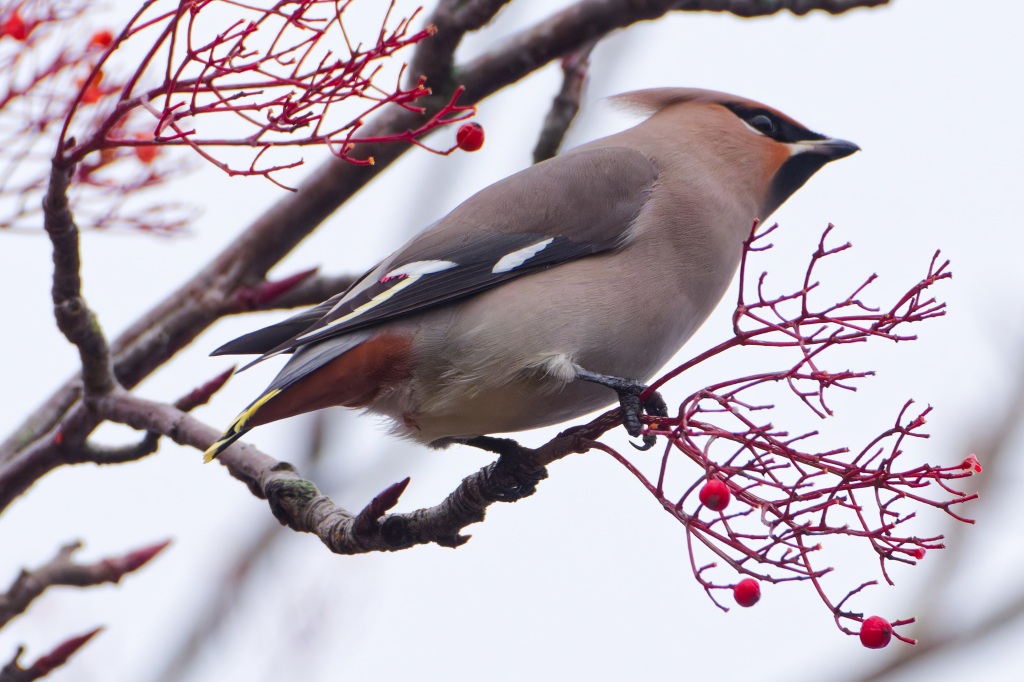
It has been quite a week. First, the most corrosive Home Secretary for a while (we must not forget the Prittster though) was ejected from the Cabinet. Scarcely had her trail of scorching bile been scrubbed from the Downing Street cobbles when the Supreme Court threw out the Rwanda wheeze. The celebrity deathmatch between the PM and the former HS continues as this post goes up. Backwoodsman hasn’t laughed so much in ages.
No-one sane can be exactly cheered by the sight of the bedraggled disembarkations from small boats on the Kentish coast but the migrants Backwoodsman encountered very recently were a joyous sight. A walk to Screwfix in Possil (it’s a glamorous life being retired) was interrupted by a clamour of wings above the big junction between the St Georges and Garscube Roads. Redwings perhaps, or Fieldfares? But no – Waxwings (the Bohemian variety)! Comin’ over ‘ere, eatin’ our berries!! Hundreds of them and very restless indeed. A veritable hurricane (pace Suella). They didn’t seem to mind people too much but they did not like traffic noise or movement one bit. When the lights changed releasing the flow along the Garscube Road, up went the Waxwings to circle, and then settle briefly in the Rowan trees by Cedar Court. Ironically, there were twitchers present who admitted to driving around Glasgow all morning chasing the birds, led by a couple of Twitter/X feeds.

Backwoodsman, who was without camera, headed to the Saracen Point shops alternately marvelling at the sight of the birds, and cursing at the lack of kit. However, he was persuaded out after lunch, with the camera, to try to find them. Astonishingly, they were still in the same area, perched in some tall trees and making feeding raids across the junction.

Backwoodsman followed. There was no-one around to upset so Backwoodsman deployed to an advanced sniper position behind an ideally-located and large traffic signal control box and the shooting began while the Waxwings gorged on Rowan berries and squabbled.

Is that the tail folded under the bird in the image above? It is an unexpected posture.

The advice under circumstances when the bird is sillhoueted against a pale sky, is to overexpose by a stop or two to bleach out the background. Data loss is a consequence so it is likely that the DxO PureRAW software is helping out considerably with these images, which still have their limitations.
Eventually, the Waxwings decided to move on, took to the wing, circled for a long time and then headed towards Maryhill. I like the way the yellow tail fringe echoes the colour on the tower block.

As usual, the BTO is a source of good stuff: “Waxwings come to the UK in search of berries when crops run low closer to their breeding grounds in Fennoscandia and western Russia…[they] can turn up at anytime during the winter and in varying numbers. This behaviour is known as ‘irruptive’ as, if berries remain plentiful in northern Europe very few Waxwings, if any, will move. The Waxwing’s favoured berry is that of the Rowan and during ‘Waxwing winters’, they can gather in large flocks at just a few Rowan trees. Waxwings can turn up anywhere in the UK, but are less commonly reported in western regions than further east.” All our local and known Rowan trees have been stripped of their berries but there are quite a few Cotoneasters bearing a rich crop. Perhaps they will be left for the Redwings and Fieldfares when they come to spend the winter with us?
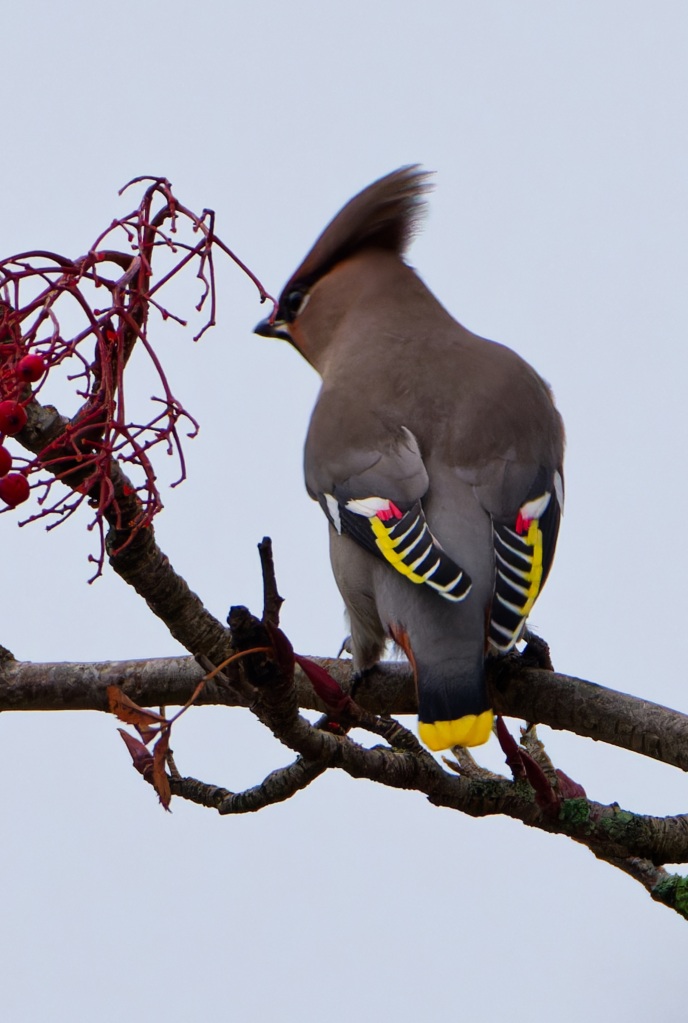
There is an excellent image on the Featherbase site which shows that the bright red pink colours arise from spurs projecting from the ends of quite large feathers, rather than just being pigmented regions of normal feathers (like the patches of yellow colouration). The spurs can be seen in some of the images in this post, with two to four spurs per wing seeming common.


There is a modest amount of writing about these spurs. For example: “Both cedar and Bohemian waxwings derive their common names from the red, waxy tips of some of their secondary feathers. The colour of this wax is due to the presence of the pigment astaxanthin. Ornithologists used to theorise that these red tips protected the feathers from wear and tear, but this has not been borne out in studies. What has been established is that the red appendages increase in both number and size with a bird’s age. Immature birds usually have between zero and six waxy tips. Older birds have more than nine. The number of tips appears to function as a signal of age and status in mate selection; individuals within these two age categories choose each other as mates. Pairs of older birds (with high numbers of red tips) tend to nest earlier and have larger clutches than younger birds.” The relevant citation for this research may be here.
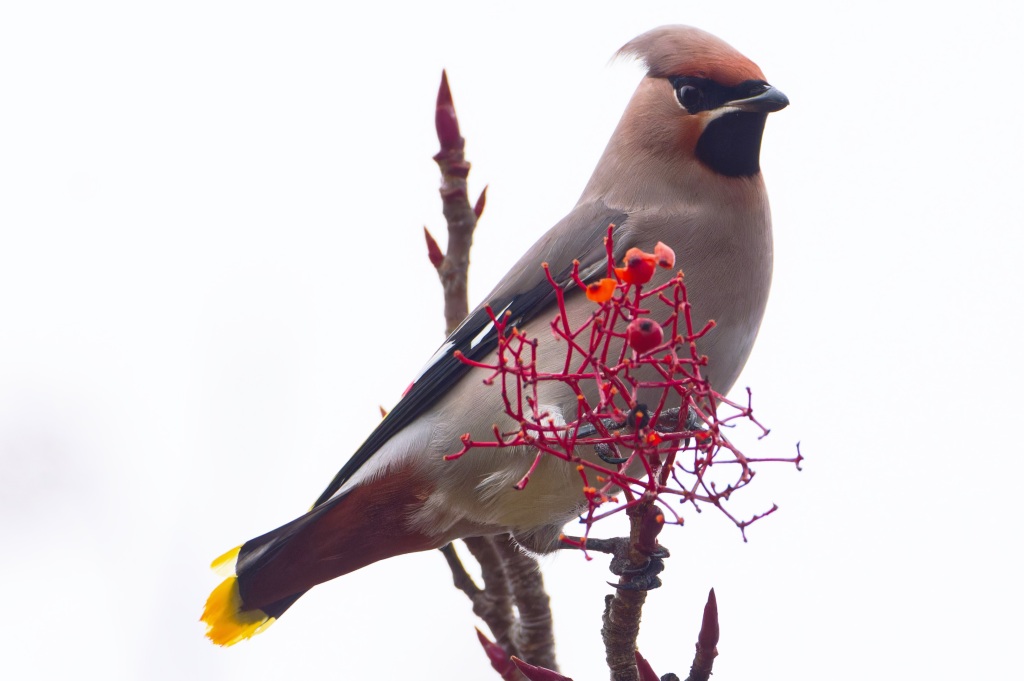

There is a particularly informative image of the relevant part of the Bohemian waxwing plumage here, with some useful writing about the related Cedar Waxwings from the US.
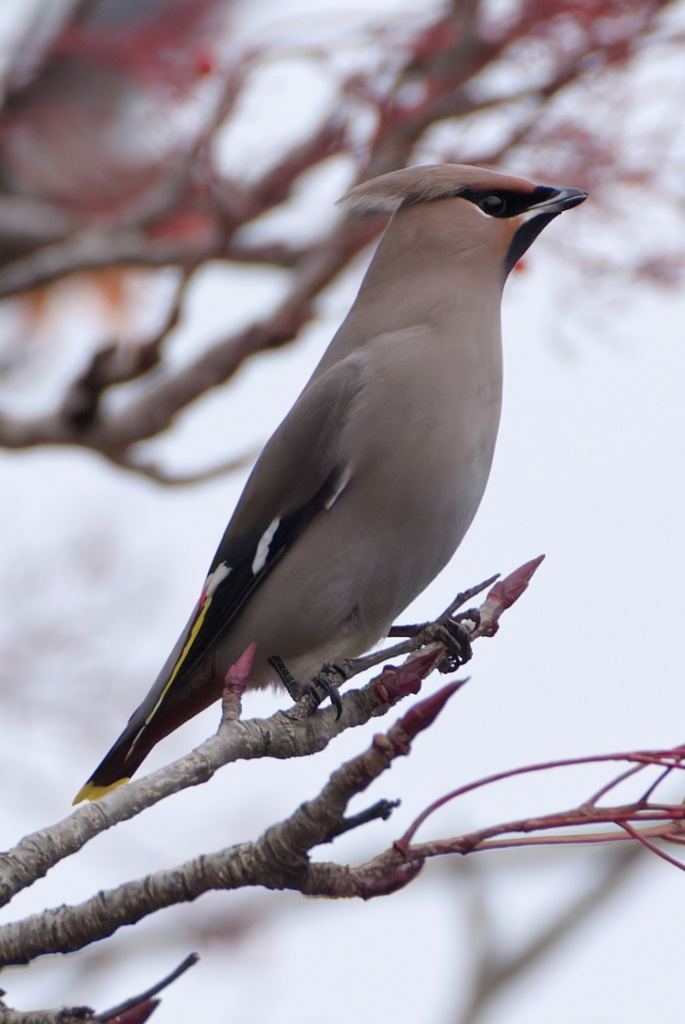
As an organic chemist by training, Backwoodsman was interested to look up the structure of astaxanthin and find that it is fairly widespread, and makes it way into Flamingos via their intake of algae. It is used as a food colouring for farmed salmon (as additive E161j).
However, there is a bit more to it. A 1963 Science paper tells us that: “The pigment on the secondary feathers of the cedar waxwing (Bombycilla cedrorum) is deposited as an amorphous layer upon a supporting medullary structure. The pigment was extracted with alkali and analysed by chromatographic and spectrophotometric methods. The results indicate that the pigment is astacene (3,3′,4,4′-tetraketo- β-carotene), the oxidation product of astaxanthin.” The medullary structure refers to a spongy medium within the long hollow shaft of the feathers. Backwoodsman believes that this text is saying that the colour is showing through the keratin cortex of a spur protruding from the secondary feathers, and is not arising from a coating of pigment-containing wax on an outer surface. The oxidation reported by this team but unnoticed by the two authors writing about Cedar Waxwings would tend to make the pigment molecule a little redder (by extending the chromophore with two extra ketonic carbonyl groups), less water soluble and probably a bit more stable than astaxanthin.
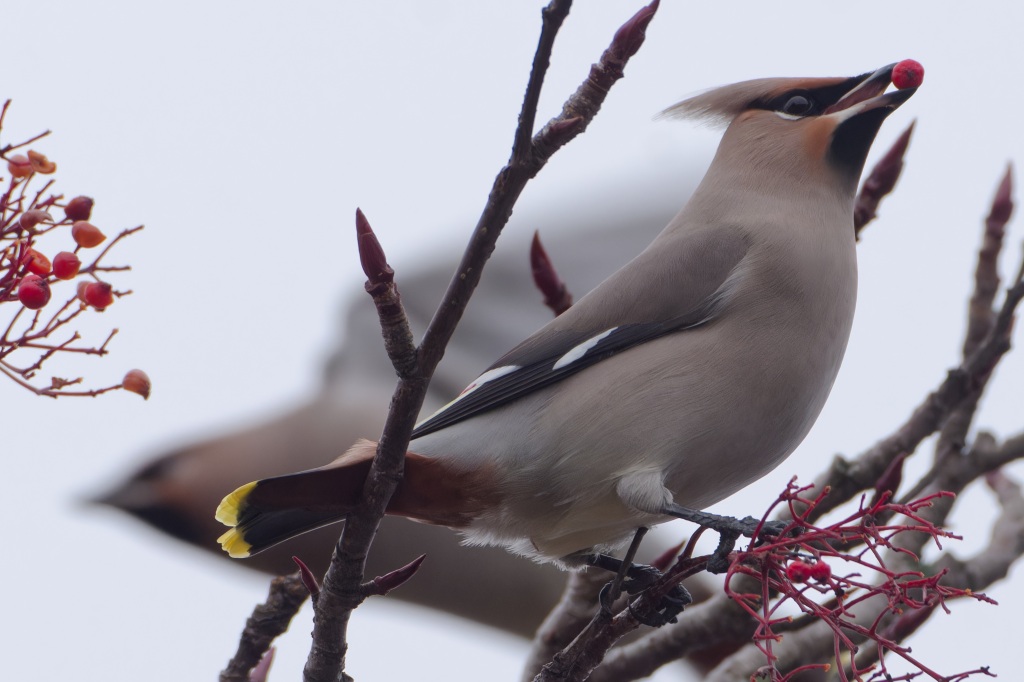
Backwoodsman returned to the photographic site twice two days later; there was some glorious autumn light in the morning and the combination of the light and the Waxwings would have produced some real knock-your-socks-off images, but it was not to be. None were present for the first visit but by the second visit, though some Waxwings had come, the light had gone. The birds (maybe two dozen this time) raided a small Rowan very briefly and then rose up and headed for Maryhill. Backwoodsman considers himself extremely privileged indeed to have been granted so much time with these birds on Wednesday November 15th.

PS The return trip took in Ruchill Park; two dozen Redwings were present, the first proper sighting of the season. They had found a stand of Cotoneasters with an abundance of berries, and were busy feeding.
